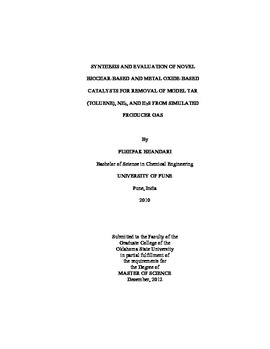| dc.contributor.advisor | Kumar, Ajay | |
| dc.contributor.author | Bhandari, Pushpak Nandan | |
| dc.date.accessioned | 2014-04-16T03:07:10Z | |
| dc.date.available | 2014-04-16T03:07:10Z | |
| dc.date.issued | 2012-12-01 | |
| dc.identifier.uri | https://hdl.handle.net/11244/9621 | |
| dc.description.abstract | Gasification is a thermochemical conversion process in which carbonaceous feedstock is gasified in a controlled atmosphere to generate producer gas. The producer gas is used for production of heat, power, fuels and chemicals. Various contaminants such as tars, NH3, and H2S in producer gas possess many problems due to their corrosive nature and their ability to clog and deactivate catalysts. In this study, several catalysts were synthesized, characterized, and tested for removal of three contaminants (toluene (model tar), NH3, and H2S) from the biomass-generated producer gas. Biochar, a catalyst, was generated from gasification of switchgrass. Activated carbon and acidic surface activated carbon were synthesized using ultrasonication method from biochar. Acidic surface was synthesized by coating activated carbon with dilute acid. Mixed metal oxide catalysts were synthesized from hydrotalcite precursors using novel synthesis technique using microwave and ultrasonication. Surface area of activated carbon (~900 m2/g) was significantly higher than that of its precursor biochar (~60 m2/g). Surface area of metal oxide catalyst was approximately 180 m2/g after calcination. Biochar, activated carbon, and acidic surface activated carbon showed toluene removal efficiencies of approximately 78, 88, and 88 %, respectively, when the catalysts were tested individually with toluene in the presence of producer gas at 800 C. The toluene removal efficiencies increased to 86, 91, and 97 % using biochar, activated carbon and acidic surface activated carbon, respectively in the presence of NH3 and H2S in the producer gas. Increase in toluene removal efficiencies in presence of NH3 and H2S indicates that NH3 and H2S play a role in toluene reforming reactions during simultaneous removal of contaminants. Toluene removal efficiency for mixed metal oxide was approximately 83%. Ammonia adsorption capacities were 0.008 g NH3/g catalyst for biochar and 0.03g NH3/g catalyst for activated carbon, acidic surface activated carbon, and mixed metal oxide catalyst. H2S adsorption capacities were 0.008 g H2S/g catalyst for all biochar-based catalysts and 0.01g H2S/g catalyst for mixed metal oxide. Thus, ultrasonication and microwave technology offer improved benefits for synthesis of high-performance catalysts intended for use in biomass-generated producer gas upgrading. High surface area biochar-based and metal-oxide based catalysts have high efficiencies for simultaneous removal of toluene, NH3, and H2S. | |
| dc.format | application/pdf | |
| dc.language | en_US | |
| dc.publisher | Oklahoma State University | |
| dc.rights | Copyright is held by the author who has granted the Oklahoma State University Library the non-exclusive right to share this material in its institutional repository. Contact Digital Library Services at lib-dls@okstate.edu or 405-744-9161 for the permission policy on the use, reproduction or distribution of this material. | |
| dc.title | Synthesis and Evaluation of Novel Biochar-based and Metal Oxide-based Catalysts for Removal of Model Tar (Toluene), Nh3, and H2s from Simulated Producer Gas | |
| dc.type | text | |
| dc.contributor.committeeMember | Huhnke, Raymond L. | |
| dc.contributor.committeeMember | Bellmer, Danielle D. | |
| dc.contributor.committeeMember | Patil, Krushna N. | |
| osu.filename | Bhandari_okstate_0664M_12462.pdf | |
| osu.college | Engineering, Architecture, and Technology | |
| osu.accesstype | Open Access | |
| dc.description.department | School of Chemical Engineering | |
| dc.type.genre | Thesis | |
| dc.subject.keywords | ammonia | |
| dc.subject.keywords | biochar catalysts | |
| dc.subject.keywords | biomass gasification | |
| dc.subject.keywords | hydrogen sulfide | |
| dc.subject.keywords | mixed metal oxide catalysts | |
| dc.subject.keywords | tar | |
